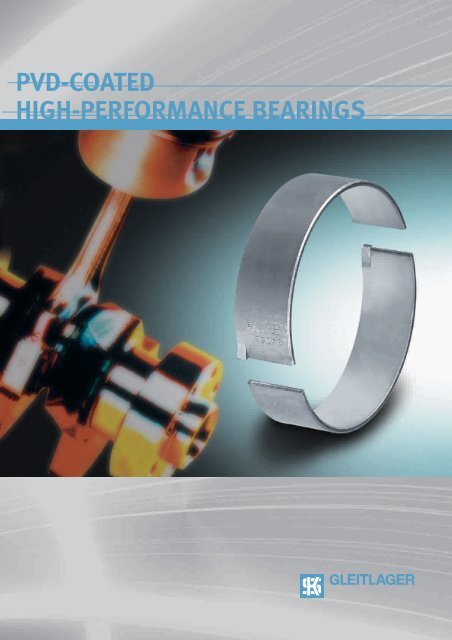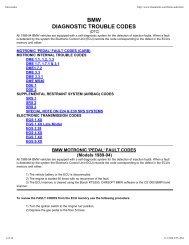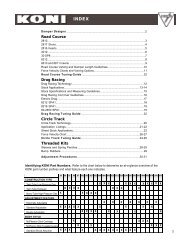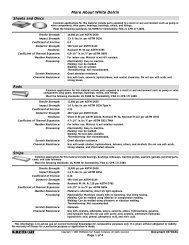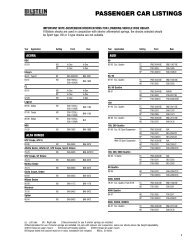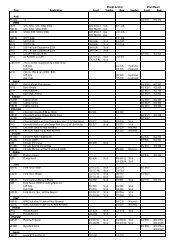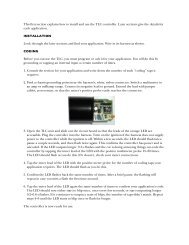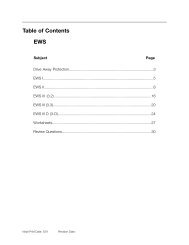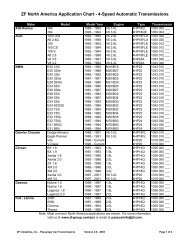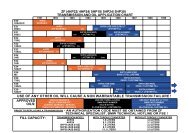PVD-COATED HIGH-PERFORMANCE BEARINGS
PVD-COATED HIGH-PERFORMANCE BEARINGS
PVD-COATED HIGH-PERFORMANCE BEARINGS
You also want an ePaper? Increase the reach of your titles
YUMPU automatically turns print PDFs into web optimized ePapers that Google loves.
<strong>PVD</strong>-<strong>COATED</strong><br />
<strong>HIGH</strong>-<strong>PERFORMANCE</strong> <strong>BEARINGS</strong>
Three-Metal Bearings reached<br />
their limits<br />
Three-metal plain bearings have<br />
been used successfully for decades<br />
as plain bearing materials for applications<br />
in engines. They consist<br />
of a steel back with a cast or sintered<br />
lead bronze layer and an<br />
electroplated lead-tin-copper sliding<br />
layer. These bearings are<br />
distinguished by their high loading<br />
PbSn10Cu2 running layer<br />
CuPb24Sn4 sliding s<br />
layer<br />
l<br />
Steel back<br />
Fig. 1: Three-metal bearing KS<br />
S43G with sintered sliding layer<br />
capacity and good tribological<br />
properties. In the course of the<br />
ongoing further development of<br />
engines to enhance performance<br />
and reduce fuel consumption still<br />
further, the loads in diesel engines<br />
in particular have increased so<br />
much that three-metal bearings<br />
have reached their limits as con<br />
rod bearings, Figure 2. The galvanic<br />
sliding layer shows signs of<br />
fatigue in the form of hen track<br />
patterns and erosion.<br />
It therefore became necessary to<br />
develop a new material to withstand<br />
higher loading combined<br />
with similarly good tribological properties<br />
such as resistance to wear<br />
and emergency running properties.<br />
In the development of plain bearing<br />
materials we exploit the fact<br />
that a bearing material's loading<br />
capacity depends on the thickness<br />
of the bearing material. The<br />
thinner a layer is, the greater its<br />
loading capacity will be. On the<br />
known three-metal bearings, an<br />
approximately 20 µm thick leadtin-copper<br />
layer with outstanding<br />
tribological properties is electroplated<br />
onto the lead bronze bearing<br />
metal. This composite material<br />
withstands loading of up to 65 MPa,<br />
while comparable bearing metal<br />
composites with a 400 µm thick<br />
sliding layer will only withstand<br />
loading up to 30 MPa.<br />
Bearing Material AlSn20Cu<br />
The bearing metal AlSn20Cu,<br />
which has also been in successful<br />
use for years, was therefore the<br />
obvious choice. It is distinguished<br />
by a loading capacity superior to<br />
that of bearing metals combined<br />
with similarly good tribological<br />
properties.<br />
However, we were still left with the<br />
problem of coating a half bearing<br />
with the demanded precision.<br />
With the known methods for the<br />
production of composites, e.g.<br />
casting, sintering, rolling and electroplating,<br />
it was not possible to<br />
apply an AlSn20Cu layer to the<br />
half bearings. A totally new coating<br />
process – <strong>PVD</strong> coating – had<br />
to be developed.<br />
Fig. 2: Development trend in plain bearings in engines<br />
<strong>PVD</strong> Coating<br />
At KS Gleitlager the development of<br />
such coating methods started at<br />
the beginning of the 1980s in close<br />
cooperation with the metal laboratory<br />
of Metallgesellschaft (the<br />
Group’s parent company at that<br />
time) and Balzers in Liechtenstein.<br />
The still valid patents for the <strong>PVD</strong><br />
coating of half bearings that KS<br />
Gleitlager holds today date back to<br />
this period. The following table<br />
lists chronologically the milestones<br />
in our development work:<br />
1983 Start of development work<br />
together with the Metallgesellschaft<br />
metal laboratory<br />
and Balzers, Liechtenstein.<br />
1988 First samples supplied to<br />
customer<br />
1989 First supply of series components<br />
(VW Corrado)<br />
1994 First supply of series components<br />
for highly-charged<br />
turbo diesel engines (VW)<br />
1995 Series supplier to Audi<br />
1996 Series supplier to Daimler<br />
Chrysler<br />
1998 Installation of a coating unit<br />
at the Papenburg site<br />
(HGL unit 1/multi-chamber<br />
unit with round target)<br />
2001 Installation of a second coating<br />
unit at the Papenburg<br />
site (HGL unit 2/single<br />
chamber unit with turntable)<br />
2003 Approval for series production<br />
at BMW.<br />
Principle of <strong>PVD</strong> Coating<br />
During <strong>PVD</strong> (Physical Vapour Deposition)<br />
coating atoms are ejected<br />
(or sputtered) from a target (coating<br />
material) by accelerated argon<br />
ions in a high vacuum. The atoms<br />
are then deposited on the workpiece<br />
(half bearing).<br />
Unlike electroplating, in which a<br />
voltage is applied between the<br />
anode and the half bearing acting<br />
as the cathode, thus facilitating a<br />
uniform deposition of metal ions<br />
over the entire surface of the half<br />
bearing, the atoms sputtered from<br />
the target cannot be “controlled”.<br />
Statistically speaking they leave<br />
the target in a cos () function.
This is of considerable importance<br />
when one considers that half bearings<br />
with a semicircular surface<br />
have to be coated. Figure 3.<br />
The surface being coated has to be<br />
exceptionally clean. Only the very<br />
slightest contamination of the surface<br />
would cause local bonding<br />
problems and hence failure of the<br />
half bearing. For technical reasons,<br />
it has proven necessary to clean<br />
and activate the half bearings<br />
within the unit before coating. For<br />
this purpose the sputtering process<br />
is reversed, with the half bearings<br />
serving as the target. From the<br />
surface of the bearing metal, the<br />
uppermost layers of atoms are<br />
removed to leave a clean and reactive<br />
metal surface ready for coating.<br />
In order to ensure that the<br />
aluminium, tin and copper atoms<br />
can be ejected simultaneously<br />
from the aluminium-tin-copper<br />
target by the argon ions, the latter<br />
have to have a certain energy<br />
distribution. The energy depends<br />
on the applied voltage and the<br />
distance covered by the argon<br />
atoms. This is in turn dependent<br />
on the distance between the<br />
plasma source and the target and<br />
the existing volume of gas.<br />
It is equally important for the heat<br />
generated by the impact of the<br />
aluminium, tin and copper atoms<br />
to be discharged in a controlled<br />
manner. To this end the half bearings<br />
are placed in coolable mountings.<br />
Heat management has a<br />
highly decisive influence on the<br />
formation of the sputtered layer. If<br />
the coating temperature is too low,<br />
the layer is very hard and brittle; if<br />
the coating temperature is too high,<br />
the layer is soft. In extreme cases<br />
low-melting tin can even melt.<br />
Coating Process<br />
Coating takes place in several<br />
stages. First of all, the half bearings<br />
are placed in their holder<br />
(mounting). The mounting containing<br />
the half bearings is then placed<br />
in the unit, the air is evacuated<br />
from the unit and the unit is flushed<br />
with argon. In the next step, the<br />
half bearings are cleaned. To this<br />
Fig. 3: Principle of <strong>PVD</strong> coating<br />
end, as explained above, the<br />
sputter process is reversed. The<br />
argon ions clean the surface of<br />
the half bearings, removing<br />
oxides and contaminants. After<br />
cleaning, the barrier layer is applied.<br />
This consists of pure nickel<br />
or nickel-chrome or nickel-copper<br />
alloys. After this, the sliding layer<br />
of AlSn20Cu is deposited. When<br />
air has been re-admitted to the<br />
unit, the mountings can be<br />
removed and the half bearings<br />
taken out.<br />
<strong>PVD</strong> Concepts<br />
For the commercial-scale coating<br />
of half bearings, three <strong>PVD</strong> unit<br />
concepts are employed today,<br />
differing in their design and the<br />
arrangement of the half bearings.<br />
In multi-chamber units the individual<br />
steps – evacuation, cleaning,<br />
application of the barrier<br />
layer, coating and admission of air<br />
– take place in separate chambers,<br />
while in single-chamber<br />
units the entire process takes<br />
place in just one chamber.<br />
a) Figure 4 shows a multi-chamber<br />
unit with a flat target (type A).<br />
The entire unit consists of an air<br />
lock chamber, cleaning chamber,<br />
coating chamber for the barrier<br />
layer, one or more coating chambers<br />
for the running layer and<br />
another air lock chamber. Platelike<br />
targets are used for coating.<br />
b) Figure 5 shows a multi-chamber<br />
unit with a round target (type B).<br />
The entire unit consists of an air<br />
lock chamber, cleaning chamber,<br />
coating chamber for the barrier<br />
layer, one or more coating chambers<br />
for the running layer and<br />
another air lock chamber. The half<br />
bearings are arranged in a starlike<br />
pattern around the round<br />
target.<br />
c) Figure 6 shows a single-chamber<br />
unit with a turntable.<br />
The entire unit consists of a single<br />
chamber in which all the process<br />
steps take place. In this unit type<br />
a turntable is loaded with half<br />
bearings and the plate-like targets<br />
are arranged around the turntable.<br />
Fig. 4: Half bearing/target arrangement
Two of these unit concepts are<br />
employed today at KS Gleitlager<br />
GmbH for the coating of half bearings<br />
on the commercial scale –<br />
the multi-chamber unit with a<br />
round target and the single-chamber<br />
unit.<br />
The following cross section,<br />
figures 7 and 8, shows the layers<br />
of a high-performance plain bearing.<br />
The AlSn20Cu layer has a very<br />
fine and uniform distribution of tin.<br />
Applications<br />
On direct-injection diesel engines,<br />
the con rod half bearings on the<br />
rod side are exposed to extremely<br />
high ignition pressures.<br />
Specific loads of over 100 MPa<br />
occur today. This is the typical<br />
field of application for high-performance<br />
plain bearings. In the cup<br />
half bearings exposed to lower<br />
loads, three-metal half bearings<br />
are still employed today. In order<br />
to meet the demand for lead-free<br />
materials under the EU Directive<br />
on End-of-Life vehicles the threemetal<br />
half bearings in many engines<br />
are being replaced with<br />
lead-free aluminium-tin-copper<br />
bearing metals.<br />
Figure 9 shows con rod bearings<br />
after 500h endurance test. In the<br />
cup side, bimetal bearings KS R30<br />
(steel back with roll bonded<br />
AlSn15Cu2 sliding layer) and<br />
trimetal bearings KS S43G (steel<br />
back with CuPb24Sn4 sliding layer<br />
and PbSn10Cu2 running layer) are<br />
mounted alternately.<br />
In the rod side, high performance<br />
bearings (KS S30S) are mounted,<br />
in the cup side bearings 1 and 3<br />
are bimetal bearings (KS R30) and<br />
the bearings 2 and 4 are threemetal<br />
bearings (KS S43G).<br />
Fig. 5: Half bearing/target arrangement<br />
(multi-chamber unit, type B)<br />
Fig. 6: Single chamber unit with a turntable
Literature:<br />
(1) H. Pfestorf, F. Weiss, K.H.<br />
Matucha, P. Wincierz: Bearing<br />
Materials in Ullmann’s Encyc-lopedia<br />
of Industrial Chemestry, VCH,<br />
Weinheim 1985<br />
(2) K.H. Matucha, H. Pfestorf, F.<br />
Weiss: Gleitlagerwerkstoffe in: O.<br />
Asbeck, K.H. Matucha Beiträge zur<br />
Metallkunde, DGM Informationsgesellschaft<br />
Oberursel 1989<br />
(3) M. Müller: Moderne Motoren<br />
benötigen Gleitlager aus modernen<br />
Werkstoffen in: Werkstoffe im<br />
Automobilbau 97/98, Sonderausgabe<br />
von ATZ und MTZ.<br />
(4) K. Deicke, Dr. K.-H. Matucha,<br />
Dr. T. Steffens, W. Schubert: KS<br />
R41B, ein Stahl-Aluminium-<br />
Verbundwerkstoff für hohe<br />
Belastungen in: MTZ 7-8/2002<br />
Fig. 7: overview<br />
High-performance bearing KS S30S<br />
AlSn20Cu<br />
Ni<br />
CuPb24Sn4<br />
Steel back<br />
Fig. 8: detail<br />
rod<br />
cap<br />
cylinder 1 2 3 4<br />
Bild 9: Bearing after test
KS Gleitlager GmbH<br />
St. Leon-Rot<br />
Am Bahnhof 14<br />
D-68789 St. Leon-Rot<br />
Phone +49 (0) 62 27-56-0<br />
Fax +49 (0) 62 27-56-3 02<br />
St. Leon-Rot, Germany<br />
www.kolbenschmidt-pierburg.com<br />
KS Gleitlager GmbH<br />
Papenburg<br />
Von Arenberg Str. 5<br />
26871 Papenburg<br />
Phone +49 (0) 4961 986-0<br />
Fax +49 (0) 4961 986-103<br />
Papenburg, Germany<br />
KS Bearings, Inc.<br />
5 Southchase Court<br />
Fountain Inn, SC 29644-9018<br />
USA<br />
Phone +1 864 688 1400<br />
Fax +1 864 688 1401<br />
KS Bearings, Inc.<br />
1515 West Main Street<br />
Greensburg, IN 47240<br />
USA<br />
Phone +1 812 663 3401<br />
Fax +1 812 663 1637<br />
Fountain Inn, USA<br />
KS Bronzinas Ltda.<br />
Rodovia Arnaldo Julio<br />
Mauerberg, n° 3920<br />
Distrito Industrial n° 01<br />
Nova Odessa - SP 13460 - Brazil<br />
Phone +55 (0) 193 466 9849<br />
Fax +55 (0) 193 466 9833<br />
Nova Odessa, Brazil<br />
A company of<br />
Kolbenschmidt Pierburg AG<br />
Subject to alterations. Printed in Germany.


